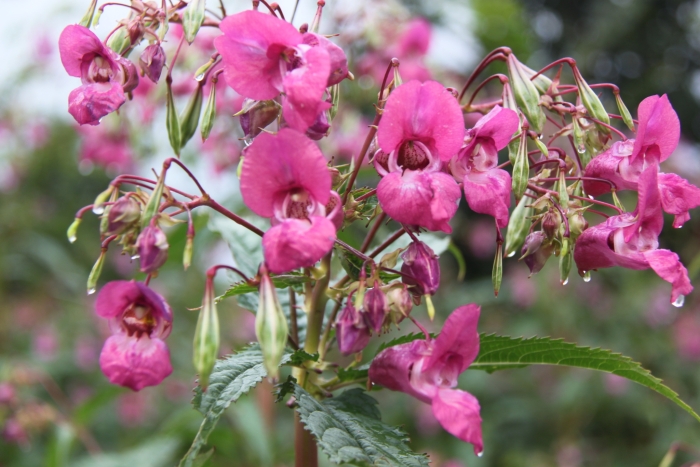Himalayan Balsam
(Impatiens glandulifera)
Himalayan Balsam (Impatiens glandulifera)
/
/

purperlibel
CC BY-SA 4.0
Image By:
purperlibel
Recorded By:
Copyright:
CC BY-SA 4.0
Copyright Notice:
Photo by: purperlibel | License Type: CC BY-SA 4.0 | License URL: http://creativecommons.org/licenses/by-sa/4.0/ | Rights Holder: purperlibel | Publisher: iNaturalist | Date Created: 2014-08-22T11:23:50-07:00 |





















Estimated Native Range
Summary
Impatiens glandulifera, commonly known as Himalayan balsam, is a large annual herb native to the river valleys of the Himalayas. It typically grows to a height of 3-7 feet (0.9-2.1 meters) and is characterized by its succulent stems and lance-shaped leaves. The plant produces clusters of pink, hooded flowers from mid-summer to early autumn, which are followed by seed pods that burst open when ripe, dispersing seeds up to several meters away. The flowers are quite showy and attract a variety of pollinators, including bees and butterflies.
Himalayan balsam is appreciated for its rapid growth and ornamental flowers, making it a popular choice for adding a splash of color to gardens. It thrives in moist soil conditions and can be found along riverbanks and wetlands in its native habitat. In cultivation, it requires consistently moist soil and can tolerate partial shade to full sun. However, gardeners should be cautious as it can become invasive outside its native range, outcompeting native flora and disrupting ecosystems. It is considered a noxious weed in many regions and is subject to control measures. When not invasive, it can be used for border planting or as a part of a wildlife-friendly garden to attract pollinators.CC BY-SA 4.0
Himalayan balsam is appreciated for its rapid growth and ornamental flowers, making it a popular choice for adding a splash of color to gardens. It thrives in moist soil conditions and can be found along riverbanks and wetlands in its native habitat. In cultivation, it requires consistently moist soil and can tolerate partial shade to full sun. However, gardeners should be cautious as it can become invasive outside its native range, outcompeting native flora and disrupting ecosystems. It is considered a noxious weed in many regions and is subject to control measures. When not invasive, it can be used for border planting or as a part of a wildlife-friendly garden to attract pollinators.CC BY-SA 4.0
Plant Description
- Plant Type: Herb
- Height: 3-10 feet
- Width: 2-3 feet
- Growth Rate: Rapid
- Flower Color: Pink, Purple
- Flowering Season: Summer, Fall
- Leaf Retention:
Growth Requirements
- Sun: Full Sun, Part Shade
- Water: High
- Drainage: Medium, Fast
Common Uses
Bee Garden, Border Plant, Butterfly Garden, Low Maintenance, Water Garden
Natural Habitat
River valleys of the Himalayas
Other Names
Common Names: Himalayan Balsam, Bobby Tops, Policeman’s Helmet, Copper Tops, Gnome’s Hatstand
Scientific Names: , Impatiens glandulifera, Balsamina glandulifera, Balsamina macrochila, Balsamina roylei, Impatiens candida, Impatiens cornigera, Impatiens glandulifera f. albida, Impatiens glandulifera f. pallidiflora, Impatiens glanduligera
GBIF Accepted Name: